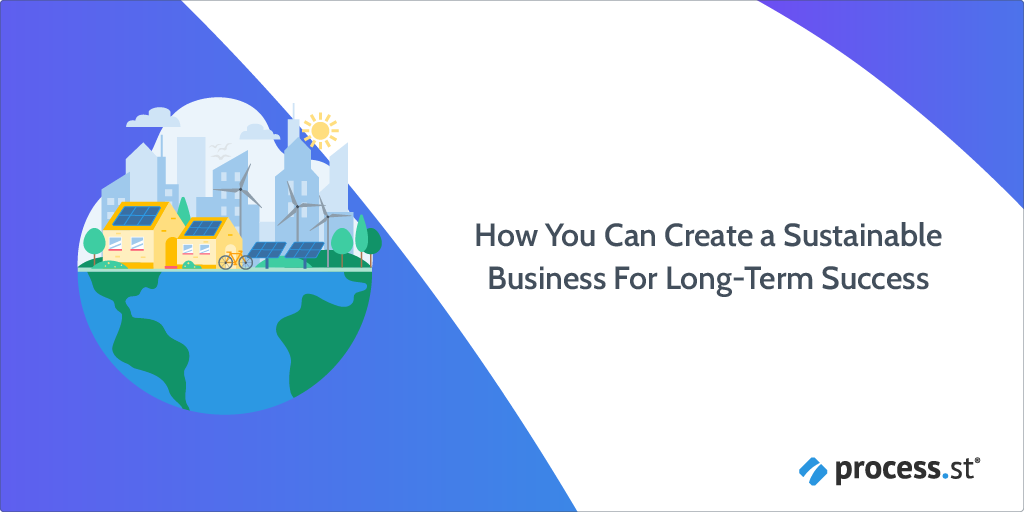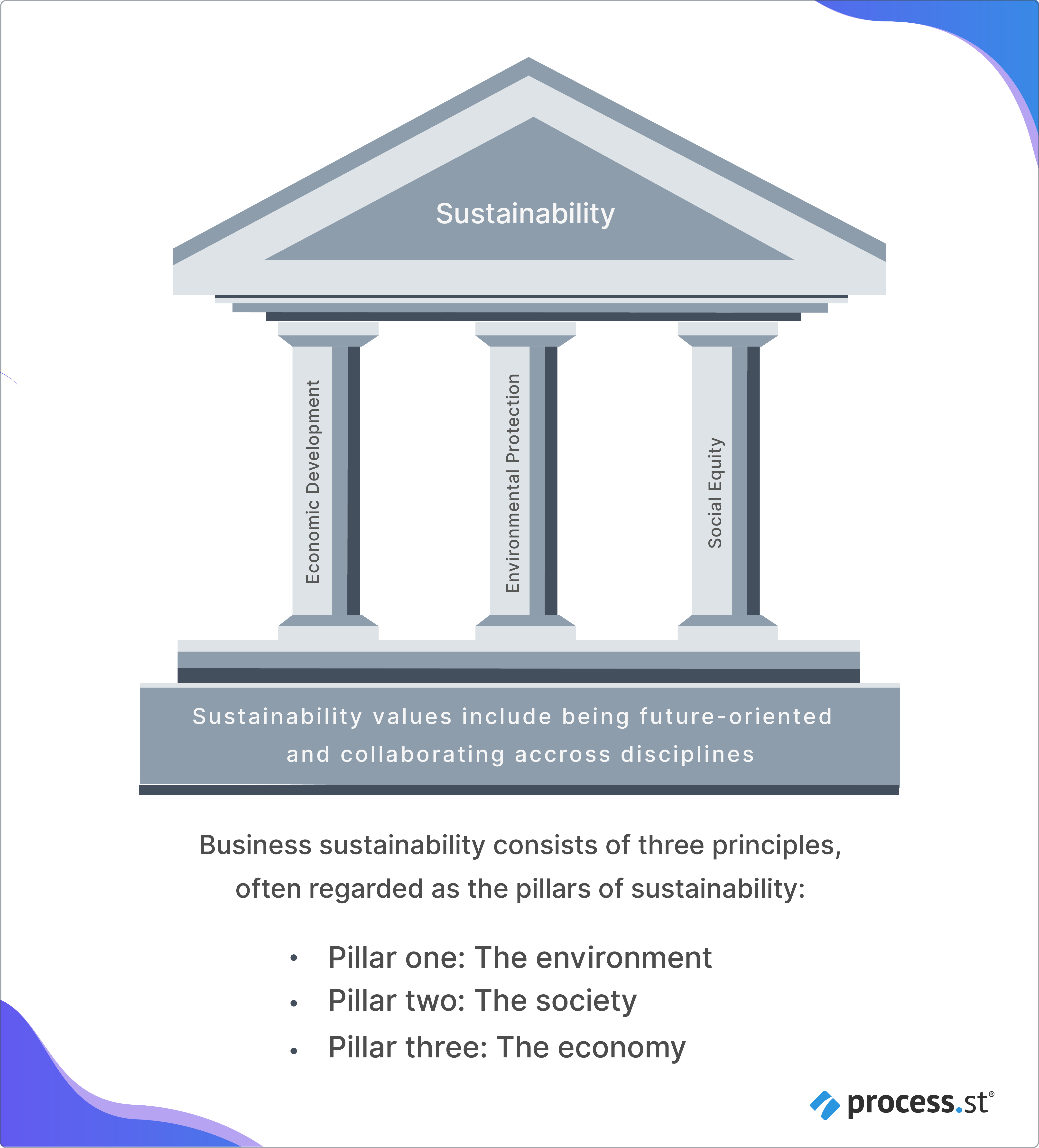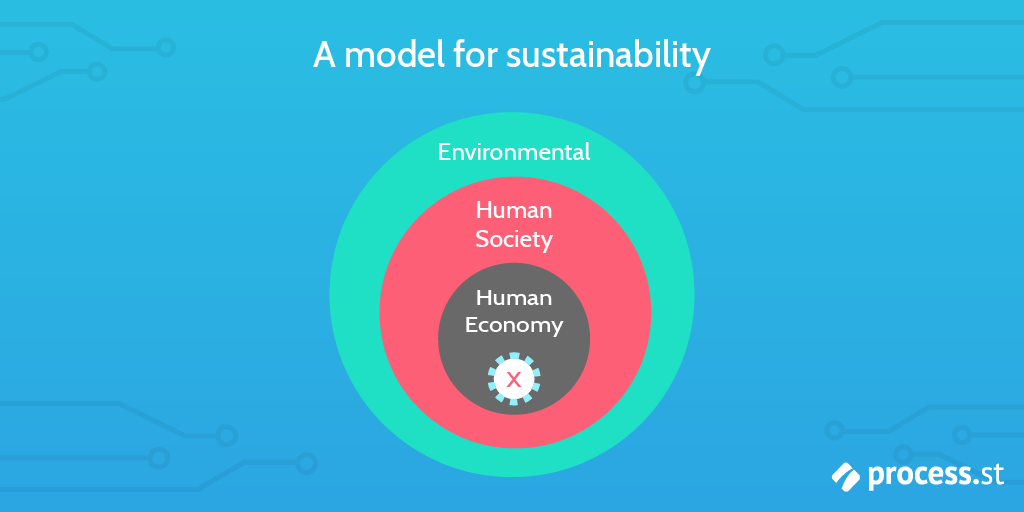
It is becoming increasingly apparent that sustained corporate success lies in harmony with a healthy society and environment.
84% of business executives recognize the importance of adopting a sustainable business. Academics, such as the environmental economist Robert Mendelsohn, agree that sustainability is key:
“We can’t afford not to be sustainable.” – Robert Mendelsohn, Can we afford sustainability?
At Process Street we also recognize the increasing priority adopting a sustainable business model should have.
In this article, we explain what a sustainable business is, why it is important, how it can benefit your business in both the short and long term, and how you can implement sustainable actions into your business. At the end of the post, we provide you with templates that act as aids to make your common business processes more sustainable.
- What is a sustainable business?
- Why business sustainability is important: The three principles of sustainability
- A model of sustainability: Three-nested dependencies model
- Case studies for sustainable business
- The short term benefits of a sustainable business
- How you can be a sustainable business
Let’s get started.
What is a sustainable business?
Sustainability is defined as:
“The ability to be maintained at a certain rate or level.” – Lexico, Definition of sustainability
If we consider sustainability in a business sense, business sustainability is the preservation of a business through time. This means infinite business success and profitability.
Who wouldn’t want that?
Despite the attractive outcome, business sustainability as a concept did not come about until the early 70s and was met with controversy. Publications such as The Limits To Growth addressed business economics beyond the profit and loss statement. This was the dawn of the green business model.
The green business model, or a sustainable business, consider social and environmental dimensions that envelop and interact with business economic development.
In short, to attain a sustainable business, environmental, social and financial demands need to be managed and regulated.
The green business model as a domain once attracted little attention. But there has been exponential growth in the number of businesses and organizations looking to minimize their social and environmental impacts. Many corporate giants, such as Wal-Mart, have named sustainability as a key priority, understanding its importance for business success.
Why business sustainability is important: The 3 principles of sustainability

Business sustainability consists of three principles, also known as pillars:
- Pillar one: The environment
- Pillar two: The society
- Pillar three: The economy
The next part of this article explains the impacts these three pillars have on business when they are not managed sustainably. We will also consider how these pillars interact with each other in a business sustainability model.
Pillar one: The environment and its impacts on business
News reports suggesting that our planet is heading towards catastrophe aren’t rare occurrences. The Guardian tells us that glaciers are melting at a rapid pace. The New Yorker broadcasts that the state of Louisiana is losing a football field of land every ~1.5 hours due to rising sea-levels. The Atlantic informs us that the Brazilian Amazon burns under the weight of unsustainable agricultural practices.
The human impact on planet Earth – in addition to its animals and plants – is outlined in the quote below:
“Humans have caused the annihilation of 83% of all wild mammals and half of all plants, the authors of the report found. And it’s not just that humans are wiping out wildlife — they’re also determining the animals and plants that remain. Of the birds left in the world, 70% are poultry chickens and other farmed birds. And of the mammals left in the world, 60% are livestock, 36% are pigs, and a mere 4% are wild.” – Erica Sanchez, Jana Sepehr, and Joe McCarthy, Humanity Has Killed 83% of All Wild Mammals and Half of Plants: Study
As upsetting as such news is on a personal level, we stand back and ask ‘what does this mean for business?’
This is the question that pillar one, the environment, addresses.
According to reports from 2018, $125 trillion is the financial worth of nature.
All businesses utilize our planet’s resources to obtain a slice of the $125 trillion pie. Whether that is using materials for physical products or energy, or relying on important natural cycles for freshwater, pollination or seed dispersal. All in all, business profits ultimately rely on what our planet gives us.
It makes sense for businesses to ensure that $125 trillion is sustained into the future, and not squandered over a short time period.
By preserving natural resources, extinction in a business sense is prevented.
Business and environmentalism as concepts are, therefore, very compatible. By ensuring our natural world and its resources are sustained into the future, businesses are maintained by virtue.
Pillar two: The society and its impacts on business
Pillar two, social sustainability, is about understanding human needs.
From a business perspective, social sustainability is realizing the impacts corporations have on workers and society as a whole. This includes accounting for human rights, health and safety, community engagement, work-life-balance, philanthropy, diversity, and equality.
With a socially sustainable strategy, the wellbeing of workers and society is optimized. This generates healthy, livable communities which enhance business economic prospects.
Professor of Accountability and CSR at the Middlesex University Business School, Adrian Henriques, states:
“Social impact includes anything that affects company-stakeholder relationships: from how much and how reliably suppliers are paid, to how a product affects lives. From how small shareholders may be treated to the impacts of alcohol on health and communities.” – Adrian Henriques, Understanding a company’s social impact is crucial to sustainability
Take Google for example. With a brand value of $309 million, the web giant must be doing something right.
One key element that’s certainly contributing to Google’s success is high employee satisfaction.
86% of Google employees state they are satisfied with their jobs. Providing flexible working hours, fun offices and encouraging collaboration and trust, Google integrates social responsibility into its business strategy and delivers a profitable company culture.
Walt Disney is another highly admired company we can learn from.
“A little consideration, a little thought for others makes all the difference.” – Winnie The Pooh, Winnie The Pooh
Walt Disney certainly practices what it preached in the childhood classic movie Winnie the Pooh. Take Disney’s voluntEARS program for instance. The program encourages employees to donate time to community service efforts. It’s a successful program, as 2.9 million hours of service have been put in since its inception.
With the long-lasting success of Walt Disney and Google’s soaring brand value, we can infer that social sustainability dramatically benefits a company’s bottom line.
Pillar three: The economy and its impacts on business
It is at pillar three, the economic pillar, where we find common ground with most businesses. To be sustainable, businesses must make a profit.
Activities that fit under the economic pillar include compliance, proper governance and risk management.
Let’s consider the oil company Shell as an example to explain pillar three.
Often deemed as ‘evil’, oil companies receive a lot of pressure to reduce the use of fossil fuels and switch to renewable sources. Investment in Shell occurs due to the returns Shell brings. But abruptly dropping fossil fuels will mean losing returns and thus investment. The adoption of renewable energy resources, therefore, has to be slow and incremental.
To achieve a successful balance, Shell has set targets to cut its net carbon footprint by 50% by the year 2050. If Shell meets these targets, Shell will have successfully balanced economic factors to meet the environmental climatic demands of being more sustainable.
Gorging on a finite resource to maximize profit has grave environmental and social costs. Yes, profit is vital for corporate success but it cannot be at the expense of the other two pillars. To truly understand why, read the next section of this article.
A model for sustainability: Three-nested dependencies model

There has been some debate over how the three pillars of sustainability interact with one another. The most accurate model proposed is the 3-nested-dependencies model.
This model represents a co-dependent reality between the environment, society, and the economy.
Human society and our economy are wholly-owned subsidiaries of the environment. Neither can prosper in the long-run without prosperous, healthy surroundings. Beyond the environment, economic success is then driven by the exchange of goods and services. This exchange is determined by social constructs and choices that make up a society. Economic success does not come with fragile, poverty-stricken, despondent communities.
In summary, a healthy economy cannot be sustained without a healthy society or environment. From the small-scale economy of a single business, up to the larger-scale global economy, all financial facets are at the mercy of social and environmental factors, and it is the environment that ultimately deals the trump card.
The next part of this article outlines case studies to show the sustainable business model and its interacting three principles, in real-life scenarios.
Case studies for sustainable business
Sustainable business case study one: The collapse of cod fisheries
The year 1993 saw the commercial extinction of the Northern Cod.
Commercial extinction is the depletion of a species population to the point where not enough can be caught and sold to earn a profit.
Cod is popular in US cuisine and is also part of the traditional British fish and chips delicacy. And it was the cod’s delectability that led to its demise.
Technological advances, like ocean-trawling and pinpointing fish using radar and electronic navigation systems, meant the number of fish caught in Canadian catches dramatically rose. Peaking in the 1970s and 1980s, the economic success of Canadian fisheries skyrocketed with the overexploitation of our environmental resource.
This success was, however, short-term.
Negative repercussions soon prevailed in 1992 as the cod species projected towards extinction. The environmental resource was not sustained.
The Canadian cod fisheries consequently collapsed. 35,000 fishermen and fish plant workers lost their jobs in the largest industrial closure of Canadian history. A non-sustained environmental resource resulted in adverse social and economic repercussions. Displaced workers were given financial aid and provided with retraining programs, all at a cost to the Canadian economy.
Sustainable business case study two: 2015 Indonesia fires
In February 2015, 5,000km of Indonesia burned under a thick smog. The vast palm oil monocultures, which provoked this catastrophe, were reduced to ash.
Torching a wonderland rich in endemic species to clear the way for plant monocultures of palm oil had always imposed a hazard. In 2015, which was a warmer year than usual, that hazard spread like wildfire over Indonesia.
Again, activities that did not account for sustaining nature caused a delayed backlash that whipped havoc over Indonesia’s society. Accounting for both direct deaths from the blaze and indirect deaths from the lingering smokey haze, 100,000 people were estimated to have died from the disaster.
The economic impacts were just as cutting. The estimated cost of these fires for Indonesia, due to humanitarian aid and loss of productive land, was around $1.6 billion.
Sustainable business case study three: Dhaka garment factory collapse
On April 24th, 2013, the factory known as Rana Plaza in Dhaka cracked and shuddered under the weight of its workers and machines. The Bangladeshi factory, serving the fast fashion industry, had its workers stitching and sewing over twelve hours a day, to take home as little as ~$50 a month each.
Structural cracks in the eight-story commercial building were reported, causing the closure of shops in its lower floors. The garment factory owners ignored warnings of potential collapse and ordered workers to continue as normal. Only hours after the cracks appeared, the entire building crumpled, killing 1,138 workers and injuring 2,600.
The world’s attention turned to the human cost of cheap, fast fashion. Brands associated with the Rana Plaza such as Mango, Primark, and H&M suffered both financially and in reputation.
By short-cutting their business’ social responsibility, these fashion companies paid an economic price in the long-run, having to fork out $21.5m to the Rana Plaza Trust Fund. The disaster brought about a campaign concerning fashion retailers and the often unfair treatment of their workers.
Sustainable business case study four: Patagonia’s “Don’t Buy This Jacket” campaign

As counter-intuitive as this advertisement may seem, the crux of Patagonia’s message is strong: do not take unless you truly need.
Founded by Yvon Chouinard, a strong environmental activist, Patagonia puts the environment at the forefront of its business operations. The social impacts of doing so are substantial. Honesty in its campaigns means Patagonia gains trust from its consumers. Taking a charitable sentiment by investing in the environment builds a strong brand that people will support, and often pay more to do so.
Patagonia’s healthy environmental stance has positive social effects for the company, creating a firm foundation of brand evangelists. In addition, the company has only a 4% employee turnover due to its strong brand message and good working conditions.
The environmental and social sustainable actions of Patagonia contribute to the company’s economic success. In 2017 Patagonia obtained $209 million in revenue, and it continues to use its increasing profit to strengthen its environmental and social mission.
The short term benefits of a sustainable business
From the above case studies, it is evident that long-term success and unsustainability are mutually exclusive.
But what about the short-term benefits of sustainability?
Let’s take the business mentioned in the last case study – Patagonia – as an example.
Adopting sustainable actions heightens Patagonia’s brand value, thereby providing them with loyal customers who are willing to financially support a brand which aligns with their own ethics and values. In fact, 81% of consumers suggest they will make a personal sacrifice to address social and environmental issues. For Patagonia, this is a huge short-term economic advantage.
The short-term benefits of sustainable actions don’t end with heightened brand value and the acquisition of loyal, well-paying customers, either:
- Being a sustainable business can help you when bidding for contracts from governmental or corporate bodies who work with sustainability.
- Focusing on sustainability allows you to scrutinize your overall business functions – specifically, where you are wasting time, effort, and money. For example, by incorporating environmental accounting procedures, you can reduce your energy costs. By improving your workplace environment, you will reduce employee turnover, save money, and benefit from increased productivity, engagement, and innovation.
Ultimately, being a sustainable business won’t just result in benefits that take years upon years to reap; there are plenty of short-term advantages that directly result in profitability.
How you can be a sustainable business
In this post, we have considered what business sustainability is, and how a sustainable business is made up of three different principles.
We have also seen why business sustainability is needed, and considered the negative impacts of being unsustainable, in addition to the positives that being a sustainable business brings.
Now we’ll look at how you can do your bit to help create a more sustainable business, and how Process Street can help you achieve your sustainability goals.
How to use Process Street to help you become a more sustainable business
As a piece of business process management (BPM) software, Process Street has targeted common business procedures and looked at how they can be made more sustainable.
We provide advice, information and template resources to facilitate you in reaching your sustainability goals.
For example, use Process Street’s environmental accounting template to make your accounting processes more sustainable. Save money by doing so and support a healthy active workforce by implementing schemes such as the cycle to work scheme.
Below are some of Process Street’s resources to help you get started and become more sustainable in your business operations.
- 12 Inspection Checklists to Maximize Safety in the Work Place
- Office Safety Inspection Checklist
- Hotel Safety Inspection Checklist
- What is IS0 31000? Getting Started With Risk Management
- ISO 45001 Occupational Health and Safety (OHS) Audit
- Warehouse Safety Checklist
- 5 Free ISO 14001 Checklist Templates for Environmental Management
- Environmental Accounting Internal Audit
- Hotel Sustainability Audit
- What is Workplace Diversity? Improving Diversity in the Workplace (8 Free Templates)
- How to Build Better Employee Accountability with Processes
- How to Get, Process and Act on Employee Feedback
- Why You Should Unleash Team Collaboration and How to Do it
Our templates have the following features to provide you with an excellent BPM tool:
- Dynamic task due dates so no task is ever left incomplete.
- Stop tasks that ensure task order.
- Integrations with other pieces of software so you can synchronize your processes.
- Conditional logic to create a dynamic process that caters to your specific needs.
- Task assignment so that you can assign the relevant team members to specific tasks.
Business sustainability is becoming increasingly important
We’ve covered:
- Unsustainable actions and long-term business success are mutually exclusive.
- Sustainable actions can provide short-term benefits as well as a myriad of long-term benefits.
- Our economy is enveloped within our society; a society that is encased within our environment in a nested-dependencies model.
- It is our environment that deals the ultimate trump card. Environmental changes will ripple down to society and finally our economy.
Focusing on the final bullet point, it is becoming more and more important for companies to adopt sustainable actions. With looming climatic changes, mass overexploitation of resources, habitat destruction, and extinction, we are pushing environmental conditions to their limits.
But by taking a precautionary principle and adopting sustainable actions, you can help both your business and the environment to thrive.
We’d love to hear about the different ways you are sustainable in your business operations in the comments, and any questions you have regarding business sustainability. Who knows, you may even get featured in an upcoming article!







 Workflows
Workflows Forms
Forms Data Sets
Data Sets Pages
Pages Process AI
Process AI Automations
Automations Analytics
Analytics Apps
Apps Integrations
Integrations
 Property management
Property management
 Customer management
Customer management
 Human resources
Human resources
 Information technology
Information technology



Jane Courtnell
Hi there, I am a Junior Content Writer at Process Street. I graduated in Biology, specializing in Environmental Science at Imperial College London. During my degree, I developed an enthusiasm for writing to communicate environmental issues. I continued my studies at Imperial College's Business School, and with this, my writing progressed looking at sustainability in a business sense. When I am not writing I enjoy being in the mountains, running and rock climbing. Follow me at @JaneCourtnell.